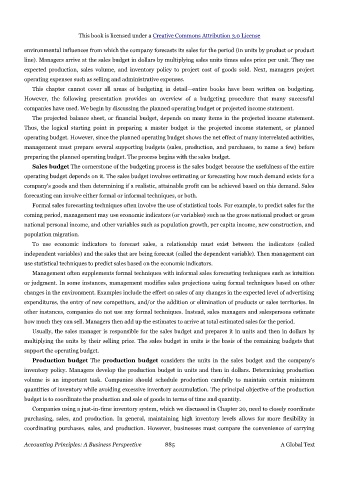Page 884 - Accounting Principles (A Business Perspective)
P. 884
This book is licensed under a Creative Commons Attribution 3.0 License
environmental influences from which the company forecasts its sales for the period (in units by product or product
line). Managers arrive at the sales budget in dollars by multiplying sales units times sales price per unit. They use
expected production, sales volume, and inventory policy to project cost of goods sold. Next, managers project
operating expenses such as selling and administrative expenses.
This chapter cannot cover all areas of budgeting in detail—entire books have been written on budgeting.
However, the following presentation provides an overview of a budgeting procedure that many successful
companies have used. We begin by discussing the planned operating budget or projected income statement.
The projected balance sheet, or financial budget, depends on many items in the projected income statement.
Thus, the logical starting point in preparing a master budget is the projected income statement, or planned
operating budget. However, since the planned operating budget shows the net effect of many interrelated activities,
management must prepare several supporting budgets (sales, production, and purchases, to name a few) before
preparing the planned operating budget. The process begins with the sales budget.
Sales budget The cornerstone of the budgeting process is the sales budget because the usefulness of the entire
operating budget depends on it. The sales budget involves estimating or forecasting how much demand exists for a
company's goods and then determining if a realistic, attainable profit can be achieved based on this demand. Sales
forecasting can involve either formal or informal techniques, or both.
Formal sales forecasting techniques often involve the use of statistical tools. For example, to predict sales for the
coming period, management may use economic indicators (or variables) such as the gross national product or gross
national personal income, and other variables such as population growth, per capita income, new construction, and
population migration.
To use economic indicators to forecast sales, a relationship must exist between the indicators (called
independent variables) and the sales that are being forecast (called the dependent variable). Then management can
use statistical techniques to predict sales based on the economic indicators.
Management often supplements formal techniques with informal sales forecasting techniques such as intuition
or judgment. In some instances, management modifies sales projections using formal techniques based on other
changes in the environment. Examples include the effect on sales of any changes in the expected level of advertising
expenditures, the entry of new competitors, and/or the addition or elimination of products or sales territories. In
other instances, companies do not use any formal techniques. Instead, sales managers and salespersons estimate
how much they can sell. Managers then add up the estimates to arrive at total estimated sales for the period.
Usually, the sales manager is responsible for the sales budget and prepares it in units and then in dollars by
multiplying the units by their selling price. The sales budget in units is the basis of the remaining budgets that
support the operating budget.
Production budget The production budget considers the units in the sales budget and the company's
inventory policy. Managers develop the production budget in units and then in dollars. Determining production
volume is an important task. Companies should schedule production carefully to maintain certain minimum
quantities of inventory while avoiding excessive inventory accumulation. The principal objective of the production
budget is to coordinate the production and sale of goods in terms of time and quantity.
Companies using a just-in-time inventory system, which we discussed in Chapter 20, need to closely coordinate
purchasing, sales, and production. In general, maintaining high inventory levels allows for more flexibility in
coordinating purchases, sales, and production. However, businesses must compare the convenience of carrying
Accounting Principles: A Business Perspective 885 A Global Text

